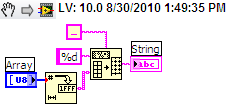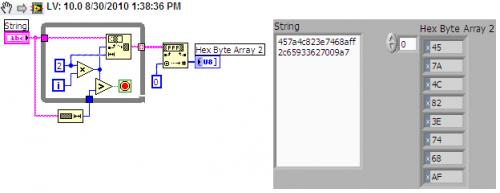-
Posts
951 -
Joined
-
Last visited
-
Days Won
39
Content Type
Profiles
Forums
Downloads
Gallery
Posts posted by jcarmody
-
-
Better put in a capital req for that 42" LCD TV monitor.
It's not December yet. We can't have 2010 capital until there's not enough time in the year to spend it. We save a fortune that way.

-
It doesn't fit on my screen.
-
-
-
I see the same in my palettes.
-
All of the above. I regularly attend\ help host the one in my area. I find it is a real good place to meet and network with people.
I agree, almost word-for-word.
-
I want to make a program where you can draw a waveform which can be later on be generated by my DAQ analog out.
I understood that part, I just don't understand why.
I've modified my earlier example to use the Waveform data type, but you'll see that it doesn't faithfully represent what's been drawn. This is where you'll have to define how to convert X-Y data into a waveform (axis scaling and handling right-to-left pen movement, to start). Do you understand what I mean?
-
 1
1
-
-
It's possible, but you'd have to validate the drawing's data before you could make it into a waveform. I've made it into an X-Y Graph by doing this:
What would your waveform look like if you moved your pen from right-to-left? That's one thing you'd need to handle.
Interesting question, however. What's your application going to do?
main.vi (LV 8.2)
-
I have a similar situation in that I'm working on abstracting CAN hardware because my company has NI, Kvaser and ValueCAN all over the place.
I've begun a BaseCAN parent class, a ValueCAN class (which will have ValueCAN-2 and ValueCAN-3 children) and a Kvaser class. My ultimate goal is to dynamically dispatch whichever child classes are required based on the hardware (as indicated by an entry in a configuration file). I've got it working for simple read/write functions.
I've printed out the document from Daklu's link about HALs. Is this along the lines of what you're discussing?
-
Thanks for answering; I feel bad for asking.
I noticed that you mentioned a release early next week. Will you be following the "release early, release often" philosophy?
-
Hi,
Yes, Mikael is correct. Myself and the rest of my collegues at AddQ left Endevo earlier this year.
I was discussing G# with a colleague this morning and mentioned that some of you had left Endevo. His first thought was to question whether it's ethical for us to use G# when it could contain some Endevo-proprietary content.
What sayest thou?
-
awesome
I disagree; I just had a few really good coaches that gave me spot-on advice. Besides, there are far too many folks on LAVA (beside whom I am an amateur) that truly deserve that distinction. I could try to list them, but it would take too long. Here's where I'd start, if I'd start.
-
After a year and a half you probably have a good foundation, but you should do better than 70%. Study the questions from the practice exam, even wiring them up yourself to verify their operation.
I passed the CLAD, CLD and CPI (Certified Professional Instructor) in less than one year without taking any NI training courses. You can, too.
-
 1
1
-
-
$25 Cold hard cash. Actually, just come to the BBQ - we'll be handing hte out there.
I won't be at NI Week or the BBQ, but I would pay for a LAVA Lanyard. Is that an option?
-
If instead of "QSM" we referred to that pattern as "Hector," I would consider that a better (if rather arbitrary) name.
HECTOR!!!!!!

-
 1
1
-
-
 Since I'm a hair color-blind, [...]
Since I'm a hair color-blind, [...]How about your avitar? Can it see colors? If not, it's a color-blind hare (with a pancake on it's head).
-
Usually there are significant bugs associated with their change they're not aware of.
You used "there", "their" and "they're" in the same sentence. You could be kicked off of the Internets.
Thank you.

-
So, is it faster than a potato?
It's faster than cooking a potato, and that's good enough for me.
-
 2
2
-
-
Opera. What's that?
Opera? Oh, it's nothing, it's just the fastest browser on Earth. Just ask them.
-
I don't see any post preview in Opera 10.53, but I'd probably like it.
-
I tied a line from a numeric control (used elsewhere) so as to set the Y.Scale.Maximum
Is that numeric control being read continuously? Could it be that it's read once and your dataflow doesn't read it when you're updating your chart?
-
I am coming up with an interactive labview questionare but am not sure what to do,please check the attachment below and advice accordingly,.....you can as well modify and send me the modified version. thanx
You ought to have done more work with Dennis' example than you did. Crosspost from here.
Here's an example of how to have each question on its own page. I used a Tab Control and hid the tabs. The Next button isn't on any of the Tab Control's pages, I've floated it over the control so it's accessible from every page.
-
[...] I could probably find the old discussion about it.
Here are two:
http://lavag.org/top...dpost__p__25408
http://lavag.org/top...iew-vi-library/
The first one sounds more like what you had in mind.
-
You're a "bird on a LabVIEW wire". Not too shabby.









[Discuss] TLB - Top-Level Baseline
in Code Repository (Uncertified)
Posted
I should have used an emoticon, sorry. I agree that BD size is not an issue with the TLB.